Greek matches
The course of the Greek matches begins near the end of the 19th century.
The Law of “Arxi” on March 27 1884 describes and defines in detail the total 12 classes of matches (different packaging, different materials, different quantities of matches).
List of matchboxes
1st period
The matchbox with the well-known abbreviated name “PYREIA SAFE” with specifications of 5th class, contains 55 safety matches, wooden. It was built in the Bavarian city of Augsburg in 1890 and circulated until 1912. It exists in two series· in the 1st it mentions “COMPANY OF PUBLIC AND MUNICIPAL WORKS” while in the 2nd “COMPANY ‘UNION’ IN AUGUST”.
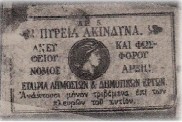
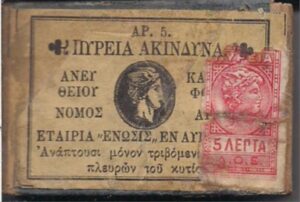
The matchbox with the indication “PARER VESTAS” that remained as its name, 12th class, wooden. It was built in Moravia in 1890 and was released until 1912.
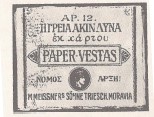
“Acropolis Rock” 1900 wooden box, small size, probably made in Sweden around 1900 with security tape. Writes “Pyreia 5 cents – Commission Financière Internationale de la Grèce “
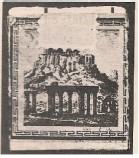
The matchbox known as “GREEK MONOPOLY MATCHES” with 5th class specifications, contains 55 safety matches and it is wooden. Made in Sweden in the first decade of 1900 and released until 1912.

“MATCHES OF GREEK MONOPOLY OF NEW COUNTRIES”. The matchboxes known with this somewhat strange indication, intended to be used exclusively in the Greek areas occupied by the wars of 1912-13. Made in Sweden in 1915 and is wooden. They were released around 1934.

“Macedonia”, 3rd class matchbox of 1915, small size, made in Sweden, wooden.

“Crete”, folder of 4th class of 1915 made in Sweden in two sizes.
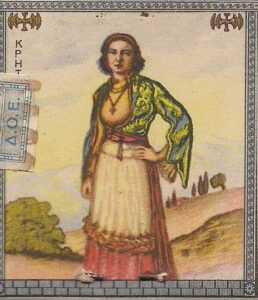

“TEMI RODI”, 3rd class matchbox of about 1915, small size that was released in Rhodes and the surrounding islands. Probably made in Italy.
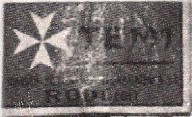
“Tsolias”, made in Finland around 1930, wooden.
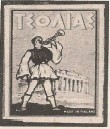
“PYREIA Ethn. Phil. Branches”, Valoukli Hospital, large wooden box of matches whose good condition is due to its silver case in which there is a name (Cleo), embossed bear on the right and date 26/10/1930. The box is older, on the back there is an appeal to philanthropists to buy these matches to boost asylum. On the side it has information about the patients and the staff of the well-known Istanbul Hospital.
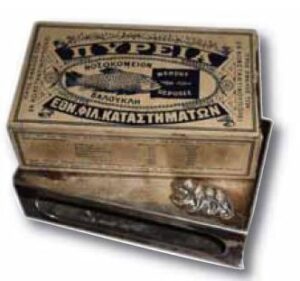
Box of matches of 1936 depicting Konstantinos Kondylis, the first Greek torchbearer in the history of the Olympic Games at the touch of the Olympic flame that took place for the first time in Ancient Olympia in the summer of 1936 for the Olympic Games in Berlin. Appears in three different versions· in the first version it is written on the front left: ALSING LONDON.

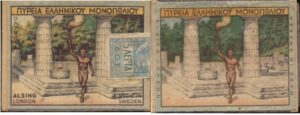
“Athena”, 1st class wooden box around 1950-60
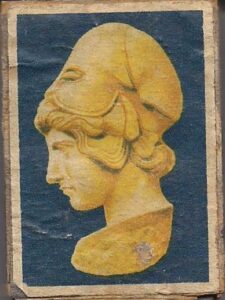
“Greek dancers”, 1st class wooden box around 1950-60
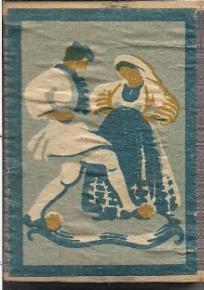
“Mykonos”, 1st class wooden box 1950-60. “Mykonos” also has been released in a cardboard box with a large size, 6th class. The security tape carried the message: “Prefer Greek Products”.
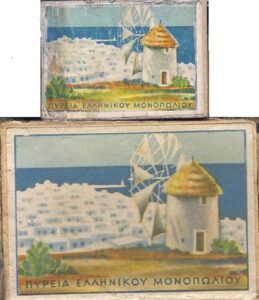

“Apollo”, 1st class wooden box, approximately 1950-60.

“Columns”, 1st class wooden box, approximately 1950-60, with safety tape.

“Deer of Rhodes”, 1st class wooden box, approximately 1950-60.
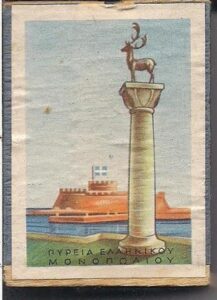

“Phaethon”, 1st class wooden box, approximately 1950-60.

“National Lottery”, 1st class wooden box, approximately 1950-60.
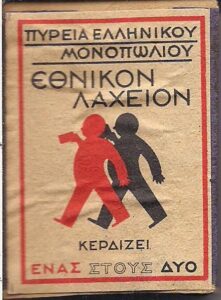
“22nd Thessaloniki International Fair”, 1st class wooden box of 1957.
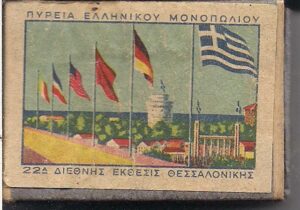
Next chronologically is the “Deer”, wooden 1st class, which means it contains 40 matches. It was released between 1950-60. “Mykonos” and the “Deer of Rhodes” are much harder to find than the “Deer”.
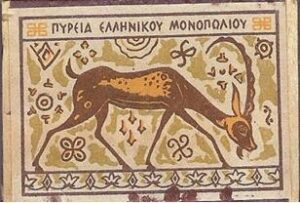
Later, the technology evolves, and after 1961 the 12 classes are merged into 4 Types (A, B, C and D).
Specifically :
Type A: paper matchboxes with 50 matches
Type B: paper matchboxes with 40 matches
Type C: paper matchboxes with 30 matches
Type D: paper sachet with 20 matches.
The type D corresponded to the fourth class and was “envelope of paper with 20 safety matches without sulfur and phosphorus”, like the modern advertising matches that have a cardboard stem and you “cut” them one by one through the envelope.
In 1961 begins the 2nd period of the matches of the Greek monopoly. At that time was created the “Artemis” matchbox, which is type A.
During this period, from 1961 onwards, matches of the monopoly will be circulated until 1986, when the Greek monopoly was abolished. These will be circulated individually, in addition to those I mention below, in order to advertise banks, hotels, insurance companies and commercial products. All these are in the collection and are also displayed in the photos.

1. 1961-1968 “ARTEMIS” (Single, wooden)
Wooden matchbox of 1961, the first to be made by the new factory of Velpex.
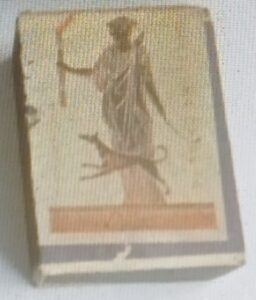
This is where the 2nd period of the Greek Matches Monopoly begins…
These matches are of A type. Their circulation was 1,182,000 pieces and were manufactured until 1968. These matchboxes were released with security tapes that carried various messages such as:
“Protect the forests”
“Do not throw lighted cigarettes”
“Prefer Greek products”
“Buy state lotteries”
“By buying lotteries you win and strengthen the institutions”
The label appears in three different shades: white, yellow and beige. In this matchbox we see a lot of misprints, mainly because the labels are often not well glued.
2. 1968-1972 – “April 21st”
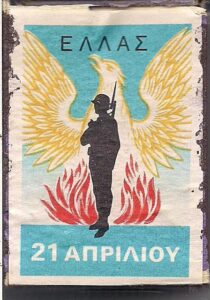
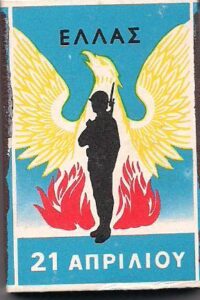
Although old, it is quite common… Thiw is the 2nd and last wooden matchbox (from there on, the paper ones are starting). Circulation of 460,000,000 pieces, some of which have safety tapes, which from time to time carried various slogans.
In February 1972 we have a new version of this matchbox in 180,000,000 pieces. It is produced by the same factory with the mark of April 21st on a label, affixed to a cardboard box, dark blue color, without the indication GREEK MONOPOLY.
With the mark of April 21st, three more editions were made, two in a wooden matchbox (one Austrian and one Polish) and one in Cypriot paper made in marine color.
In a photo here and in its second edition, of 1972, in a cardboard matchbox now, and with completely different colors. It was published in two different types:
Type A with 50 matches and Type B with 40 (the thinnest), made in Cyprus.
Much more hard to find than the common”April 21st” with normal colors.
3. 1972 – “Heroes of 1821”

At the beginning of 1972, the Greek Monopoly released for the first time a commemorative series of 10 paper matchboxes (until then Greek Monopoly produced only individual matches), depicting heroes of the revolution of 1821. On the back they bear the mark of April 21st.
It is type A, with a circulation of 228,722,000 pieces· although this is a relatively large circulation, the series is quite hard to find in good condition and complete!
There are two varieties, with different reverse types. One with white background and one with orange. The series with the orange reverse is much rarer.
4. 1972 – “Stamps of the 1896 Olympic Games” (8 pieces)

They were released on May 1 and July 30, 1972. A commemorative series of 8 paper matchboxes depicting the first Greek sports stamps issued at the 1st Olympics of 1896.
On the back they depict the logo of the Olympic Games and are considered as a commemorative series on the occasion of the 20th Olympics in Munich. They were released in only 3 months with a circulation of 30 million pieces and are type A ‘.
This series is also quite hard to find. It differs from the later series in consisting of 8 matchboxes and not 10 like the most.
5. 1972 – “Ancient Ceramic Art”
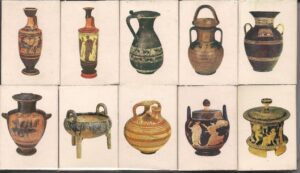
A series of 10 paper matchboxes depicting archaic pottery from the Museum of Kerameikos. On the back there is a decorative pattern. 66 million units were released. It is type B (40 matches). There is also a variety with a beige background on the facades instead of white.
6. 1972 – “Bond Loan 1972” (Individual)

This matchbox is type A (50 matches), it was circulated in 80 million pieces and on its front it shows a signal with three arrows and it has the phrase: SUBSCRIBE TO THE UNDERTAKING BOND LOAN 1972.
7. 1973 – “Greek Gardens – Flowers”

A series of 10 type A paper matchboxes depicting Greek flowers.
700 million copies were circulated in two editions until 1975. In the first edition, in the back, above and below the letters, the font is white, while in the second edition there are rectangular black backgrounds. The “almond” matchbox is the same in both versions.
At first these matchboxes were distributed throughout Greece but then their circulation was limited only to the province.
8. 1973 – “Greek Local Costumes”

A series of 10 paper matchboxes depicting Greek local costumes from collection of the Lyceum of Greek Women. 420 million units were in circulation until 1977. It is type A. In this series there is an error, in the matchbox “Sifnos”! In the normal and common “Sifnos” the woman looks to the left, while in the wrong and rare one she looks to the right!
9. 1973 – “Volanakis – Ports & vessels”
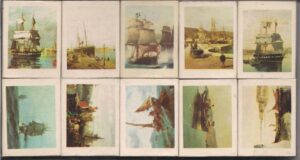
A series of 10 paper matchboxes B type, with paintings by K. Volonakis from the National Gallery.
Circulation 290 million pieces in 4 editions:
Version A: On the back above the sign “HELLENIC MONOPOLY” and below from the indication “GREEK STATE MONOPOLY” the background is white (rarer than the others).
Version B: On the back, above & below the above indications, there is a decorative
Archaic meander in marine color.
Version C: On the back, above & below the indications, there are black backgrounds. Also the letters of the C edition are more intense than the A . In all three versions, the matchsticks have a red head.
Version D: Same as C with the difference that the matchsticks have a green head.
Far more rare is the first version.
10. 1976 – “Acropolis – Theater of Dionysus” (2 paper sachets of type D)




A series of two D type sachets (20 paper matches) depicting the Acropolis and the Dionysus Theater as well, in two versions, one with a blue and the other with a red border.
11. 1977 – “Greek Forests “
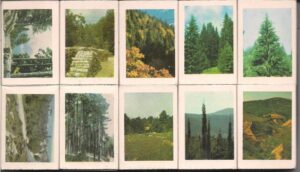
March 1977. A series of 10 paper matchboxes on the subject of reforestation and the usefulness of forest wealth. It is only type B (40 matches).
12. 1977 – “Hellenic Red Cross – 100 years in the service of the people”
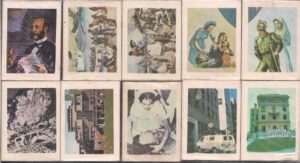
Commemorative series with 10 paper matchboxes for the 100 years of the Hellenic Red Cross. They depict scenes from the activity of H.R.C.
Rare series with small circulation. Issued in A and B type. Circulation of 6 million pieces each type.
13. 1977 – “Nautical Week 1977”

June 1977. The first commemorative series of 10 paper matchboxes out of the 5 series in total that were released (1977-78-79-80 and 1982) depicts various boats, mainly warships. Circulation of 30 million pieces of type A and 20 million of type B. Although its circulation is not the smallest of the 5 years of Nautical Week, it is still difficult to find it!
14. 1977 – “Lacalut Fluor Toothpaste” (Single matchbox)

In January 1977, was released a small edition of 5 million pieces of paper matchbox of type A. Advertising version.
15. 1977 – “Agricultural Bank of Greece” (Individual matchbox)
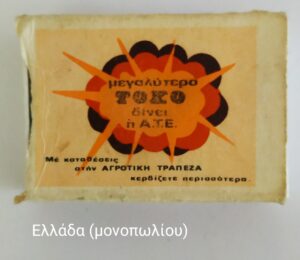
” Agricultural Bank gives more interest”. In February 1977 it was released in small circulation of 5 million pieces of A type paper matchbox. Advertising version.
16. 1977 – “Credit Bank” (Individual matchbox)
In June 1977, a paper matchbox in type A was released. On the front it says: CREDIT BANK. Hard to find. Advertising version.
Apart from these individuals, many other individuals have been released, listed in the “Countries” category.
17. 1977 – “Exportable Greek Products”

1st series “Hellenic Export Promotion Organization”. In December 1977, only 50,000 were released for the first time in Lavrio (Velpex). Type B matchboxes, which depict on their front 10 different exportable products. These matchboxes were not released in Greece but in the International Exhibitions abroad in which our country participates.
2nd series “Export Promotion Organization (OPE)” 1978. In May 1978, only 100,000 matchboxes of type B were released. They are identical on the front with those released in December 1977, while on the back except for the OPE mark also it is written: HELLENIC ORGANIZATION FOR THE PROMOTION OF EXPORTS. These matchboxes were promoted in Bulgaria for free distribution to the visitors of the exhibition of Greek Industrial & Craft Products and were NOT released in Greece.
18. 1978 – “150 years of Navarino Battle”
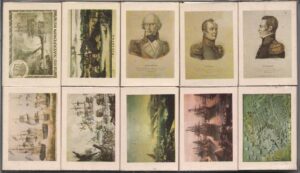
October 21, 1977 marked the 150th anniversary of the naval battle at Navarino and in commemoration of the event a series of 10 pieces was released. These matchboxes are type A in 20 million pieces and type B in 10 million pieces.
The type A was released in mid-June 1978 and the type B later.
19. 1978 – “Naval Week 1978”
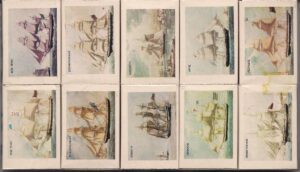
At the beginning of July 1978, the 2nd series of 10 pieces on the subject of the navy was released.
They were issued in type A with a circulation of 10 million pieces and type B with 5 million pieces.
The most rare of the five “Nautical Weeks”, especially the second type!
20. 1979 – “Embroidery of Crete “
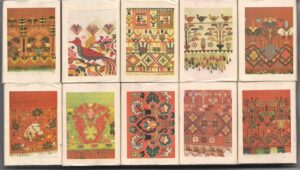
“Year of the Greek tradition”. A series of 10 paper matchboxes that was released in May 1979 as part of events for the year of “Greek Tradition” in replacement of “Greek local costumes”. It is type A.
21. 1979 – “Ceramic Art Items”. Folk ceramics.
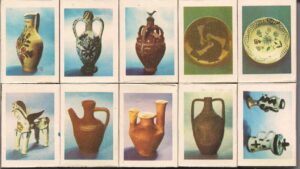
A series of 10 paper matchboxes that was released in May 1979 as part of events for the year of “Greek Tradition” in replacement of the “Greek Forests” of 1977. They are A and B type.
22. 1979 – “NauticalWeek”
A series of 10 paper matchboxes with the same facades as the 1978 Nautical Week.
Also type A and B type as of 1978.
The difference is that on the back it has a similar signal but with different shades such as the blue sky instead of white and also the sea dark brown / black instead of white.
Another key difference is that the year is NOT written at all. The phrase “HELLENIC MONOPOLY” is now written in vernacular language.
23. 1979 – “International Year of the Child”
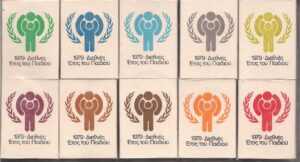
Series of 10 paper match boxes A and B type. On the back it says: “Humanity owes the Child the best it has to give”.
(UN Declaration for the Rights of the Child ,1959)
24. 1979 – “Energy Saving” (5 pieces)
“Energy without waste”. Series of 5 pieces of paper matchboxes. Type A circulation of 30 million pieces, and type B 10 million pieces. Here we have identical fronts and different backs on each of the 5 matchboxes. So they have the following different slogans on the back:
“Good engine maintenance and prudent driving save petrol”.
“Good thermal insulation means warmth in winter, coolness in summer and fuel economy”.
“Regular maintenance of heating systems pays off many times over in fuel economy”.
“The solar water heater saves electricity”.
In the boxes of type A we have two versions where on the back it is written “HELLENIC MONOPOLY” in different orthography . There is also a variety of type A with a beige background instead of white.
25. 1980 – “50 years of Air Force” (6 pieces)

A series of 6 paper matchboxes with an aviation theme. Issued in A and B type.
26. 1980 – “Images from the Greek islands”
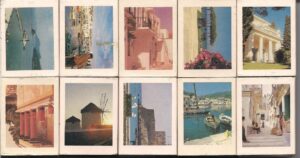
Series of 10 paper matchboxes in A type only with themes from Paros, Paxos, Rhodes, Kefalonia, Mykonos, Corfu, Corfu-Achillion, Paros, Symi and from Knossos.
A photo from Mykonos has been entered in “Paros” incorrectly.
27. 1980 – “Images of Greek islands from the Greek National Tourism Organization archive”
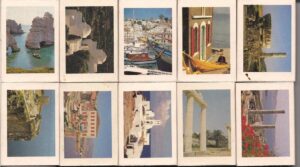
2nd row of 10 paper matchboxes with the theme of our islands.
It is only type B and presents topics from Mytilene, Milos, Samos, Sifnos, Kos, Symi, Rhodes, Delos, Sifnos. In this 2nd row the letters on the back are blue, while in the 1st row black.
28. 1980 – “Nautical Week 1980”


The 4th series “Nautical Week”. It consists of 10 paper matchboxes and was released in A type and B type with 5 million copies. Rare series with small circulation.
29. 1980 – “Ancient Olympic Games”

A series of 10 paper match boxes A and B type of the Greek monopoly with representations from ancient games.
30. 1980 – “Fire Brigade”

“50 years in the fight against fire”, 1980. A series of 10 paper matchboxes A and B type with a circulation of only 5 million pieces in each type. Rare series. On the front there are photos from the activities of the Fire Service. From this row onwards, all rows are numbered on the back with blue or yellow numbers from 1 to 10 for the 10 different matchboxes in each row.
31. 1980 – “Cigarette or Health?”
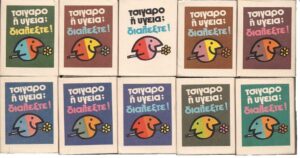
Series of 10 type A and B type paper matchboxes. On the back it says: WORLD HEALTH ORGANIZATION – MINISTRY OF SOCIAL SERVICES – GREEK STATE MONOPOLY.
Type A with a very small circulation of only 2,5 million pieces and type B with a small circulation of 5 million pieces.
Type A is definitely one of the most rare series of the Greek Monopoly.
32. 1981 – “State Lottery”

“State Lotteries”, 1981. Series of 10 paper match boxes A and B type, made by VELPEX. It advertises all state lotteries such as Popular, National and State while on the back it carries various slogans. Its circulation is: Type A 15 million pieces and Type B 5 million pieces. Type B in particular is one of the hard-to-find series of the Greek Monopoly.
33. 1982 – “Scout Guides”

“50 YEARS OF GREEK SCOUTING “, 1982, series of 10 paper matchboxes.
Type A with only 3 million pieces. From this series onwards the Types and Classes are abolished. All matchboxes are now available only in type A (50 matches). Rare series!
34. 1982 – “Nautical Week 1982”

The 5th and last series on “Nautical Week”. It was released in type A and has a circulation of 10 million copies.
35. 1982 – “Pan-European Games 1982”

“XIII EUROPEAN SPORTS CHAMPIONSHIP”, series of 10 paper match boxes A with the theme of the hare and the turtle competing in various sports. On the back, apart from “GREEK MONOPOLY”, it is also written at the bottom “GREEK STATE MONOPOLY”.
36. 1982 – “60 years of the Smyrna Catastrophe”
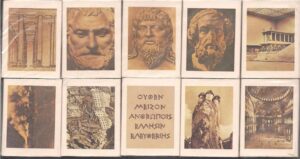
“60 YEARS WITHOUT ASIA MINOR “, 1982, series of 10 paper matchboxes only A type with
photos of Greek philosophers, important events, places, etc. Circulation 10 million pieces.
37. 1982 – “Hellenic Gendarmerie”

“HELLENIC Gendarmerie”, 1983, series of 10 paper matchboxes A type for the 150
years of the Greek gendarmerie. Circulation of the series 10 million pieces. Rare series.
38. 1983 – “Tourism in Greece”

“TOURISM ALL YEAR ROUND IN GREECE, FROM THE GREEK NATIONAL TOURISM ORGANIZATION ARCHIVE”, series of 10 papers type A matchboxes with topics from Greece such as cycling, swimming, fishing, horseback riding etc. The rear view at the bottom writes: GREEK STATE MONOPOLY.
